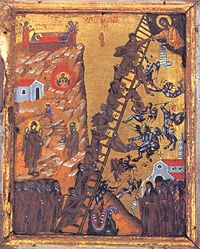John Climacus
| John Climacus Ἰωάννης τῆς Κλίμακος | |
|---|---|
Orthodox icon showing monks ascending to (and falling from) full spiritual attainment, as described in the Ladder of Divine Ascent. | |
| John of the Ladder, John Scholasticus, John Sinaites, John of Sinai | |
| Born | ca. 525 in Syria |
| Died | March 30, 606 |
| Venerated in | Roman Catholic Church Eastern Catholic Churches Eastern Orthodox Oriental Orthodox |
| Feast | March 30 |
John Climacus (Ἰωάννης τῆς Κλίμακος ca. 525 – 30 March, 606), also known as John of the Ladder, John Scholasticus and John Sinaites, was a 6th century Christian monk at the monastery on Mount Sinai. <expand here>
He is revered as a saint by the Roman Catholic, Oriental Orthodox , Eastern Orthodox and Eastern Catholic churches.
Biography
He was born in Syria, and came to the monastery and became a novice when he was about 16 years old, taught by monk named Martyrius. After the death of Martyrius John, wishing to practise greater mortifications, withdrew to a hermitage at the foot of the mountain. In this isolation he lived for some twenty years, constantly studying the lives of the saints and thus becoming one of the most learned doctors of the Church. In 600, when he was about seventy-five years of age, the monks of Sinai persuaded him to put himself at their head. He acquitted himself of his functions as abbot with the greatest wisdom, and his reputation spread so far that pope Gregory the Great wrote to recommend himself to his prayers, and sent him a sum of money for the hospital of Sinai, in which the pilgrims were wont to lodge. Four years later he resigned his charge and returned to his hermitage to prepare for death.
<more here>
The translations of the Scala by Arnauld d'Andilly (Paris, 1688) is preceded by a life of the saint by Le Maistre de Sacy. There is also in existence an ancient life of the saint by a monk named Daniel.
Theological Output
He wrote a number of instructive books, the Scala (Climax) or Ladder of Divine Ascent, composed at the request of John, Abbot of Raithu, a monastery situated on the shores of the Red Sea; and the "Liber ad Pastorem". The style of John Climacus' Ladder is based on theologoumena (plural; singular theologoumenon, errant theological opinion), not on akriveia, or necessary, explicit theological expositions of the Faith. Without Scriptural citations, his tollhouses and stages are his unique expression of tangential phenomena, a pietistic yet spurious view of human ascension without regard to the direct and immediate access provided by Christ.
The Scala describes how to raise one's soul to God, as if on a ladder. This book is one of the most widely read among Eastern Orthodox Christians, especially during the season of Great Lent which immediately precedes Easter, and on the 4th Sunday of Great Lent he is especially commemorated. The book discusses monastic virtues and vices and holds dispassionateness (apatheia) as the ultimate contemplative and mystical good in a Christian. There are thirty steps of the ladder, which correspond with the age of Jesus at His baptism and the beginning of ministry. An icon known by the same title depicts several people climbing a ladder; at the top is Jesus, prepared to receive the climbers into Heaven. Also shown are angels helping the climbers, and demons attempting to shoot with arrows or drag down the climbers, no matter how high up the ladder they may be. Most versions of the icon show at least one person falling.
Hesychasm
Veneration
His feast day is March 30 in East and West. The Orthodox Church also commemorates him on the fourth Sunday of the Great Lent. Many churches are dedicated to him in Russia, including a church and belltower in the Moscow Kremlin. John Climacus was also known as "Scholasticus," but he is not to be confused with St. John Scholasticus, Patriarch of Constantinople.
Notes
ReferencesISBN links support NWE through referral fees
This article incorporates text from the public-domain Catholic Encyclopedia of 1913.
- Butler, Alban. Lives of the Saints. Edited, revised, and supplemented by Herbert Thurston and Donald Attwater. Palm Publishers, 1956.
- Duffy, John. "Embellishing the Steps: Elements of Presentation and Style in "The Heavenly Ladder" of John Climacus." Dumbarton Oaks Papers 53 (1999). 1-17.
- Farmer, David Hugh. The Oxford Dictionary of Saints. Oxford; New York: Oxford University Press, 1997. ISBN 0192800582.
- John Climacus. The Ladder of Divine Ascent (Scala paradisi). Translation by Colm Luibheid and Norman Russell; notes on translation by Norman Russell; introduction by Kallistos Ware; preface by Colm Luibheld. New York; Toronto: Paulist Press, 1982. ISBN 0809123304
External links
All links retrieved December 19, 2007
Credits
New World Encyclopedia writers and editors rewrote and completed the Wikipedia article in accordance with New World Encyclopedia standards. This article abides by terms of the Creative Commons CC-by-sa 3.0 License (CC-by-sa), which may be used and disseminated with proper attribution. Credit is due under the terms of this license that can reference both the New World Encyclopedia contributors and the selfless volunteer contributors of the Wikimedia Foundation. To cite this article click here for a list of acceptable citing formats.The history of earlier contributions by wikipedians is accessible to researchers here:
The history of this article since it was imported to New World Encyclopedia:
Note: Some restrictions may apply to use of individual images which are separately licensed.
